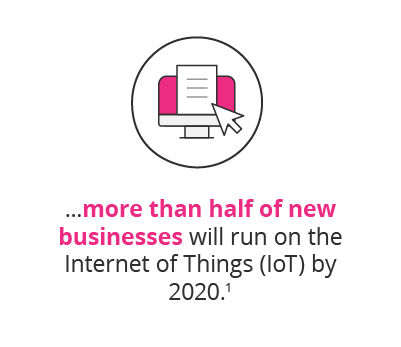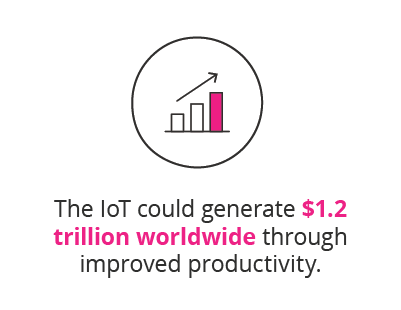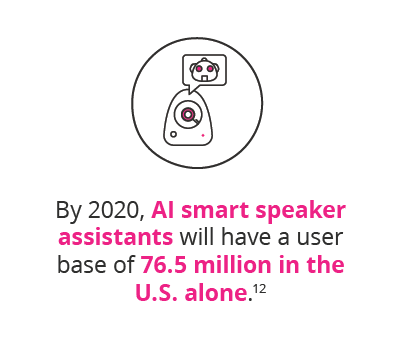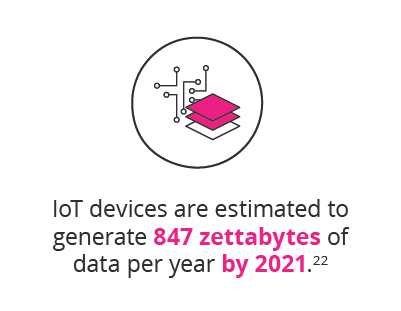How the IoT Can Improve Business Productivity
Thanks to the emergence of increasingly sophisticated connected devices, we’re currently on the cusp of a new era of business productivity. Experts predict that more than half of new businesses will run on the Internet of Things (IoT) by 2020,1 making them more automated and saving them millions in increased productivity in the process.2 However, with grand promises like these floating around, many managers are asking the question: How can the IoT practically and realistically help my business work smarter?
What is the IoT?
In its most general sense, the term ‘Internet of Things’ encompasses everything connected to the internet. However, it’s increasingly being used to define devices that specifically communicate with the local network, the internet, and each other, independent of human action.3
Today, there are billions of devices around the world that are connected to the internet, and are constantly collecting and sharing data. That said, ‘IoT’ is often used to refer to those that wouldn’t usually be expected to have an internet connection.4 For this reason, IoT devices include not only computers, laptops and smartphones, but also general objects that have been equipped with chips to gather and communicate data over a network.
Thanks to wireless networks and smaller, more powerful processors, it’s now possible to turn anything, from a fish tank to an industrial machine, into part of the IoT.5 As a result, these otherwise ‘dumb’ devices are able to bring together the digital and physical world and take over tasks previously done by humans.6

According to Investopedia, “The goal behind the Internet of Things is to have devices that self report in real time, improving efficiency and bringing important information to the surface more quickly than a system depending on human intervention.”7 In order to reach this goal, the number of IoT devices has exploded in recent years. In fact, by one estimate, there will be as many as 50 billion devices connected to the Internet by the year 2020.8
6 Ways the IoT is making businesses more productive
Smart devices are making offices more productive in a number of ways. By implementing them into everyday processes, the IoT can streamline routine tasks, fine-tune operations, and reduce overall costs. In fact, one report predicts the IoT could generate $1.2 trillion worldwide through improved productivity.9 Here are just some of the ways they’re helping businesses:
Improving collaboration
One of the ways that employee productivity is being improved is through the increased possibilities for remote working. Harnessing connected devices means that employees are no longer required to be in the same physical space as one another to collaborate. Cloud-hosted software and portable devices allow your employees to manage their work from anywhere over shared networks. According to a Harvard Business Review survey, 58% of respondents report they have seen increased collaboration within the business thanks to IoT-based initiatives.10

Increasing office efficiency
With IoT technology comes the possibility of automation. Smart offices make use of a number of connected devices that monitor, control, and manage various operations across a business.11 Using these to automate repetitive tasks normally held by employees can increase efficiency and free up their time to focus on more complex work.
IoT developments could also help your team perform tasks more easily. According to a prediction by eMarketer, by 2020, artificial intelligence (AI) smart speaker assistants like Alexa and Siri will have a user base of 76.5 million in the US alone.12 With this in mind, there’s potential for increased productivity as AI assistants streamline tasks throughout the day by learning from your habits and linking with other devices to become part of the IoT ecosystem.13 They can also help employees to manage their schedules in order to use their time more effectively – and in turn, be more productive.
As such, companies are starting to invest more and more in both smart speakers for work and voice-enabled AI applications that will allow employees to interact with virtual assistants to get work done without ever touching a keyboard.14
Coordinate operations
The huge amounts of data collected from IoT devices can be utilised in an incredible number of ways, and it’s this that makes the IoT so beneficial for businesses. One way this data is being harnessed is to help to fine-tune day-to-day operations. For example, some companies are using smart sensors in their buildings to see when certain rooms are most occupied and where employees spend the majority of their time.15
This information can then be used to schedule meetings more efficiently, and can minimise the disruptive effect meetings can have on workers’ productivity.
Lowering energy costs
In addition to improving employees’ productivity, the IoT can help businesses make more efficient use of resources and minimise unnecessary expenses. One example of this is the use of smart heating and lighting systems. Systems like the Nest Thermostat can help lower energy expenditure from overuse of air conditioning and heating.16 These cost savings can add up over the course of a year, especially if your company is in a large building.
Improving the supply chain
The IoT allows you to track the transport and delivery of products, helping you monitor arrival times and logistics more accurately.17 Smart tags and sensors can also help keep track of inventory levels in real time and can even track where an item is in a warehouse or store.18 This allows for more efficient stocking, which can improve your company’s cash flow. More precise inventory tracking also means you’re able to reduce over-ordering, and make sure the most popular products are in stock to maximise profits.19

Tracking manufacturing
An IoT empowered manufacturing process could allow you to monitor factory assets more easily than ever before. Smart sensors can detect and notify you of any issues in real-time – faster than any person would. When individual components break down, you can find them instantly based on the data they send out, and replace them with ease before they cause more damage. This is particularly beneficial if you run a complex operation that can be very costly to shut down when unexpected issues arise.20
How to prepare for an IoT future
While the future of IoT is full of promise, businesses need to put preparations in place to ensure they make the most of what it has to offer, and stay secure in doing so. Some things you’ll need to consider when implementing IoT devices are:
Appointing experts to interpret data
IoT sensors provide an endless flow of data that could provide businesses with insights into how to improve efficiencies. Being able to decipher this data is crucial for making the most of it.21
But organising the massive amounts of data from IoT devices is a big job. Companies need to hire or train a team of data analysts and managers assigned to interpreting the data so that they can react to it and make strategic decisions based on it.
Preparing for your data storage needs
Since IoT devices tend to collect huge amounts of data, with Cisco estimating that they will generate 847 zettabytes per year by 2021,22 you’ll need to find a place to store it all. One option for this is to invest in your own local data storage system. This has the advantage of speed, but is usually a more expensive solution. The other is to look to a cloud storage provider, which is likely a more cost-effective choice and has more potential for scalability.23 Edge computing has also emerged as a possible solution. Instead of data being stored on the cloud or core network, it’s pushed to the ‘edge’ of the network for quick access and to prevent data overload.24
Focusing on cybersecurity
In an increasingly connected world, it’s fair to surmise that cybersecurity risks will continue to grow. Everything that’s connected to the internet can be hacked, and IoT products are no exception. In 2017, the FDA reported that St Judes Medical implantable cardiac devices had a vulnerability that left them open to hacking – one that could allow the attacker to deplete the battery or administer incorrect pacing or shocks.25 This is just one of many examples of IoT devices that have left the user open to becoming a victim of cybercrime.
A report from Samsung says the need to secure every connected device by 2020 is critical. The firm’s Open Economy document says, “There is a very clear danger that technology is running ahead of the game”. The firm said more than 7.3 billion devices will need to be made secure by their manufacturers before 2020.26
As devices become more connected, security has become the primary concern among the general public and businesses alike.27 Ensuring you have a security plan in place for your IoT devices means that you’ll be better prepared to protect your data from bad actors.
What lies ahead for the IoT?
According to one estimate from International Data Corporation (IDC), IoT spending will reach $1.2 trillion by 2022.28 With this in mind, it’s predicted that around $6 billion will flow into the creation of IoT solutions, including application development, device hardware, system integration, data storage, security, and connectivity. It’s also predicted that those investments will generate $13 trillion by 2025.29
Throughout this development, platforms that let you view incoming data and take control of digital tools will continue to be the glue that holds the IoT together, allowing users to take full advantage of the disruptive potential of connected devices. These platforms allow the IoT to achieve its transformational potential, letting businesses manage devices, analyse data, and automate workflows.

Security concerns will drive regulation
With the increase in IoT devices, security and privacy concerns are rising across the globe. In mid-2018, the European Union implemented the General Data Protection Regulation (GDPR). GDPR has led to similar security and privacy initiatives in several nations around the world.30 These policies will continue to help protect users’ information and regulate how marketers and companies are able to harness connected devices as the market grows.
5G will enhance IoT possibilities
With 5G connections, the combination of speed, responsiveness and reach could unlock the full capabilities of emerging technologies, offering a boost to self-driving cars, drones, virtual reality and the internet of things.31
Forbes predicts that in the coming years 5G will officially become an IoT enabler, helping innovators gain the tools they need to solve old problems and create new conveniences. “Manufacturers will [also] expand and redevelop their factories and warehouses to support 5G networking, infrastructure, and security to create new 5G products and remake and reimagine old ones.”32
With this level of development, businesses will need to ensure they have a sound strategy for implementation to create an IoT ecosystem that works both efficiently and securely.
Connected intelligence will flourish
Recently, there has been significant investment in the convergence of IoT and AI. In 2018, Microsoft announced its vision for Intelligent Cloud and Intelligent Edge. Together, they offer a comprehensive service that allows devices to perform artificial intelligence tasks locally but still remain connected to the cloud for management purposes and to offer real-time data insights. This builds a useful framework for finding business solutions to everyday issues and inefficiencies.33
As this technology matures we will start to see the scenarios for IoT develop significantly beyond the traditional use cases we see today.34 This could result in intelligent buildings, cities, and task management across the board,35 helping society be more efficient and our workforce more productive than ever before. As such, we’ll continue to see businesses focus more on safeguarding and storage needs as they take advantage of all the benefits IoT has to offer, now and in the future.
Learn more about the business opportunities offered by the Internet of Things with this online program from MIT Sloan.
- 1 Burgess, M. (Feb, 2018). ‘What is the Internet of Things?’. Retrieved from Wired.
- 2 (Dec, 2017). ‘5 areas where the IoT is having the most business impact’. Retrieved from Forbes.
- 3 Burgess, M. (Feb, 2018). ‘What is the Internet of Things?’. Retrieved from Wired.
- 4 Ranger, S. (Aug, 2018). ‘What is the IoT? Everything you need to know about the Internet of Things right now’. Retrieved from ZDNet.
- 5 Meola, A. (May, 2018). ‘What is the Internet of Things (IoT)? Meaning and definition’. Retrieved from BusinessInsider.
- 6 Ranger, S. (Aug, 2018). ‘What is the IoT? Everything you need to know about the Internet of Things right now’. Retrieved from ZDNet.
- 7 Kenton, W. (Dec, 2018).‘What is the Internet of Things?’. Retrieved from Investopedia.
- 8 Afshar, V. (Mar, 2017). ‘Cisco: Enterprises are leading the Internet of Things innovation’. Retrieved from HuffingtonPost.
- 9 Marr, B. (Aug, 2015). ‘3 ways The Internet Of Things will change every business.’ Retrieved from Forbes.
- 10 (Nd). ‘Internet of Things: Science fiction or business fact?’. Retrieved from Harvard Business Review. Accessed on 29 Mar 2019.
- 11 Sears, A. (Sep, 2017). ‘How the Internet of Things can boost business productivity’. Retrieved from Live Plan.
- 12 Koetsier, J. (May, 2018). ‘Smart speaker users growing 48% annually, to hit 90M in USA this year’. Retrieved from Forbes.
- 13 Isaac, T. (Apr, 2018). ‘How to engage your employees with AI voice assistants’. Retrieved from Enterprise CIO.
- 14 Sears, A. (Sep, 2017). ‘How the Internet of Things can boost business productivity’. Retrieved from Live Plan.
- 15 Sears, A. (Sep, 2017). ‘How the Internet of Things can boost business productivity’. Retrieved from Live Plan.
- 16 Guta, M. (Sep, 2017). ‘Nest unveils new smart thermostat to help your small business save even more’. Retrieved from Small Business Trends.
- 17 Bryan, D. (Feb, 2019). ‘Four ways to help improve the supply chain with the Internet of Things’. Retrieved from Supply Chain Digital.
- 18 Macfarlane, D., et al. (Nd). ‘The impact of automatic identification on supply chain operations’. Retrieved from MIT.
- 19 Sears, A. (Sep, 2017). ‘How the Internet of Things can boost business productivity’. Retrieved from Live Plan.
- 20 Sears, A. (Sep, 2017). ‘How the Internet of Things can boost business productivity’. Retrieved from Live Plan.
- 21 Gregory, M. (2018). ‘Is the IoT really improving productivity?’. Retrieved from New Era Technology.
- 22 (Nov, 2018). ‘Cisco Global Cloud Index’. Retrieved from Cisco.
- 23 Sears, A. (Mar, 2018). ‘How to prepare your company for the coming IoT boom’. Retrieved from IoT For All.
- 24 Pickell, D. (Sep, 2018). ‘The Internet of Things will be everywhere and anywhere.’ Retrieved from G2 Crowd.
- 25 (May, 2017). ‘The 5 worst examples of IoT hacking and vulnerabilities in recorded history’. Retrieved from IoT For All.
- 26 Burgess, M. (Feb, 2018). ‘What is the Internet of Things?’ Retrieved from Wired.
- 27 Meola, A. (May, 2018). ‘What is the Internet of Things (IoT)? Meaning and definition’. Retrieved from Business Insider.
- 28 (Jun, 2018). ‘IDC forecasts worldwide technology spending on the Internet of Things to reach $1.2 trillion in 2022’. Retrieved from IDC.
- 29 Meola, A. (May, 2018). ‘What is the Internet of Things (IoT)? Meaning and definition’. Retrieved from Business Insider.
- 30 Symanovich, S. (Nd). ‘The future of IoT: 10 predictions about the Internet of Things’. Retrieved from Norton.
- 31 Cheng, R. (Mar, 2017). ‘Not just speed: 7 incredible things you can do with 5G’. Retrieved from CNET.
- 32 Zeine, H. (Nov, 2018). ‘What the future of IoT and 5G may look like’. Retrieved from Forbes.
- 33 (Nd). ‘What are the Intelligent Cloud and the Intelligent Edge?’. Retrieved from Microsoft Azure.
- 34 (Sep, 2018). ‘The future of IoT is AI’. Retrieved from Tech UK.
- 35 (Sep, 2018). ‘The future of IoT is AI’. Retrieved from Tech UK.
